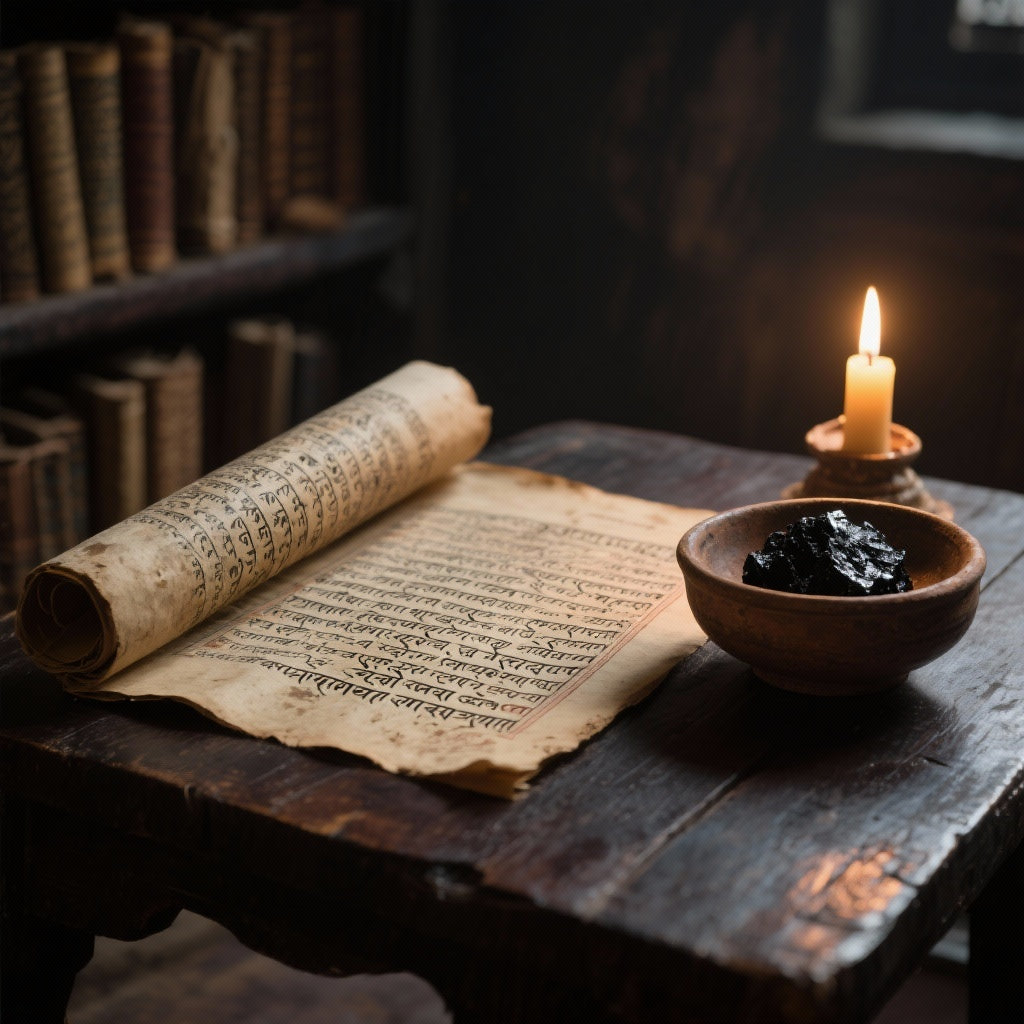5 sacred texts that mention the Shilajit and their revelations about its powers
Long before modern science could analyze its components, Shilajit was already a revered substance, a treasure of nature whose powers were recorded in humanity's most sacred texts. Nicknamed "the conqueror of mountains" or "the destroyer of weakness," this resin exudes from the rocks of the Himalayas, carrying within it the ancient wisdom of the Earth. You might wonder how such a simple substance could have captivated the attention of ancient sages and physicians?
The answer lies not in a test tube, but in ancient manuscripts that describe Shilajit not as a mere supplement, but as a divine panacea. This article invites you on a journey through time, to discover five foundational texts that have revealed and preserved the secrets of Shilajit for future generations. Prepare to see this black resin not as a product, but as a legacy.
1. The Charaka Samhita: Shilajit as a Universal Panacea
Considered one of the cornerstones of Ayurvedic medicine, the Charaka Samhita (circa 300-200 BCE) is an encyclopedic treatise on health and disease. It is in this text that the Shilajit receives one of his highest distinctions. The author, the acharya Charaka, makes a bold statement:
"There is practically no curable disease that cannot be controlled or cured with the help of Shilajit."
This powerful statement positions Shilajit not as a specific remedy, but as a Rasayana —a supreme agent of rejuvenation and longevity. The text explains that Shilajit, when properly administered to a healthy person, produces immense energy, strength, and vitality. For the sick, it acts as a catalyst for healing, addressing the root cause of imbalance. The Charaka Samhita emphasizes the importance of purifying Shilajit to unlock its full potential, wisdom that still guides quality preparation processes today.
2. The Sushruta Samhita: Shilajit as a Metabolic Regulator
Contemporary with the Charaka Samhita, the Sushruta Samhita is another fundamental text of Ayurveda, particularly famous for its detailed chapters on surgery. But the Sushruta also devoted a significant portion of his work to internal medicine, where Shilajit plays a key role.
The Sushruta Samhita is one of the earliest texts to specifically document the efficacy of Shilajit in treating Madhumeha , the ancient term for diabetes. It is described as a substance capable of regulating sugar metabolism and strengthening the urinary system. This age-old wisdom resonates with modern research investigating the effects of fulvic acid (a key component of Shilajit) on insulin sensitivity and pancreatic health. The text also highlights its antiseptic and anti-inflammatory properties, recommending it for healing fractures and regenerating tissue.
Beyond theory: a practical vision
What makes these texts so fascinating is their holistic approach. They don't simply list benefits; they explain how and why Shilajit works in harmony with the body. It is this profound understanding that distinguishes it from a mere folk remedy and elevates it to the status of a therapeutic pillar.
3. Astanga Hrudayam: Shilajit, the Supreme “Yogavahi”
Written by the sage Vagbhata around the 7th century, the Ashtanga Hrudayam is a concise and poetic synthesis of the teachings of the Charaka and the Sushruta Samhita. This text highlights a unique property of the Shilajit: its Yogavahi power.
The term Yogavahi translates as "catalyst." It refers to a substance that has the ability to transport and amplify the effectiveness of other nutrients or herbs directly into the cells and deep tissues of the body. The Ashtanga Hrudayam describes Shilajit as the most powerful of the Yogavahis. In other words:
- Effective Carrier: It helps with the absorption of vitamins and minerals.
- Bio-amplifier: It increases the potency of other medicinal plants taken at the same time.
- Targeting Agent: It directs nutrients to where the body needs them most.
This revelation is crucial. It explains why Shilajit is often included in complex Ayurvedic formulations. It doesn't just act on its own; it makes the entire system smarter and more efficient. This synergy is reflected in our approach to wellness.
4. The Bhavprakash Nighantu: The Alchemical Classification of Shilajit
Later (around the 16th century), the Bhavprakash Nighantu is a lexicon of Ayurvedic materia medica that offers an almost alchemical perspective on Shilajit. This text is famous for its detailed classification of Shilajit into four types, based on the type of rock from which it is derived:
- Sauvarna (Gold) Shilajit: Reddish in color, it is considered the most powerful for balancing the three doshas (Vata, Pitta, Kapha).
- Rajat (Silver) Shilajit: White in color, it is recommended for imbalances related to Pitta (metabolic fire).
- Tamra (Copper) Shilajit: Blue in color, it is ideal for Kapha imbalances (structure and fluidity).
- Lauha (Iron) Shilajit: Blackish-brown in color, this is the most common and recommended type for Vata imbalances and for its rejuvenating properties.
This classification demonstrates the level of sophistication achieved by ancient physicians. They did not view Shilajit as a monolithic substance, but rather as a spectrum of remedies with specific affinities for different body types. This is an invitation to a personalized approach to well-being, a concept at the heart of our lifestyle philosophy.
5. Tibetan Medical Texts (Gyushi): The "Brag-shun", Jewel of the Mountains
The wisdom of Shilajit transcends the borders of India. In traditional Tibetan medicine, whose foundations are recorded in the Four Medical Tantras (Gyushi), Shilajit is known as Brag-shun , which literally means "sweat of the rock".
Tibetan texts describe it as a "jewel of medicine," capable of treating liver ailments, strengthening digestion, and, above all, increasing the body's "metabolic heat." Brag-shun is considered a powerful tonic for the kidneys, which in this tradition are seen as the seat of ancestral vital energy. Its use in combating chronic fatigue and increasing vitality at high altitudes is particularly emphasized, a logical observation given its Himalayan origin.
"The Brag-shun conquers the hundred diseases," says a Tibetan proverb, echoing the words of Charaka from centuries earlier.
Conclusion: A Bridge Between Ancient Wisdom and Modern Wellbeing
Through these five sacred texts, Shilajit reveals itself to be much more than a simple resin. It is a golden thread that connects millennia of knowledge about health and vitality. From the Charaka Samhita , which proclaims it a universal panacea, to the Sushruta Samhita , which praises its metabolic power, to its catalytic nature in the Ashtanga Hrudayam , its precise classification in the Bhavprakash Nighantu , and its status as a jewel in Tibetan medicine, the message is constant: Shilajit is a profound gift of nature.
Today, we are fortunate to have access to this ancient wisdom. Each drop of pure Shilajit is an invitation to connect with this history, to nourish our bodies not only with minerals, but with a legacy of well-being. Explore its benefits for yourself and discover how to integrate this force of nature into your daily life, perhaps even through innovative recipes .











